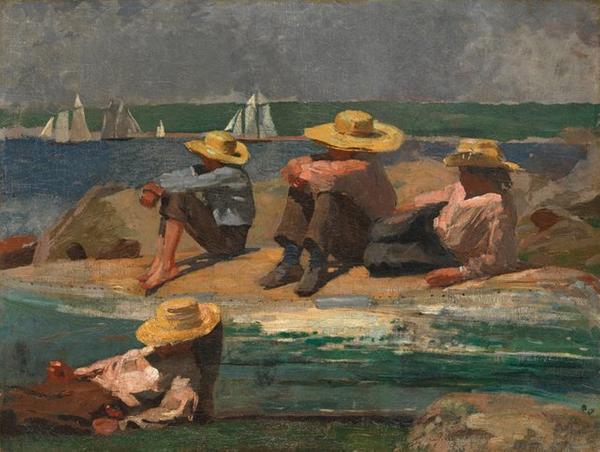Cape Ann Museum
Aug. 3 to Dec. 1, 2019

examination of the formation of this great artist as a marine painter. The Cape Ann Museum will be the sole venue for this exhibition (on view Aug. 3 to Dec. 1, 2019), which will include loans from some 40 public and private collections.
In 1869, Winslow Homer (1836–1910) exhibited his first picture of the sea. He was an ambitious New York illustrator—not yet recognized as an artist—and freshly back from France. Over the next 11 years, Homer’s journey would take him to a variety of marine destinations, from New Jersey to Maine, but especially—and repeatedly—to Gloucester and other parts of Cape Ann.
It was on Cape Ann that Homer made his first watercolors and where he discovered his calling: to be a marine artist. And it was in Gloucester in 1880, at the end of these 11 years, where he enjoyed the most productive season of his life, composing more than 100 watercolors of astonishing beauty. Homer’s journey forever changed his life and the art of his country.
This exhibition will reveal new aspects of Homer, for the first time placing these paintings, drawings and even ceramic work in their rich geographic, cultural and historical settings, on the 150th anniversary of Homer’s first paintings of the sea.
Homer at the Beach: A Marine Painter’s Journey, 1869-1880 at the Cape Ann Museum will run concurrently with Winslow Homer: Eyewitness at the Harvard Art Museums, a complementary exhibition opening August 31st.
Winslow Homer (1836 - 1910)
"Woman on the Beach, Marshfield," 1874
Watercolor and graphite on paper
The Arkell Museum has loaned three of its watercolors by Homer; On the Beach, 1869, The See-Saw, ca. 1873, and Woman on the Beach, Marshfield, 1874.
Cape Ann has long been recognized as one of this country’s oldest and most important art colonies and the collection of the Cape Ann Museum contains examples of works by many of the artists who put the community on the map including Marsden Hartley, Cecilia Beaux, Edward Hopper and John Sloan. At the heart of the Museum’s holdings is the single largest collection of works by early 19th century artist Fitz Henry Lane (1804-1865). A native of Gloucester, Lane worked as a lithographer and a painter and his works on display at the Cape Ann Museum capture the town’s busy seaport in its heyday.